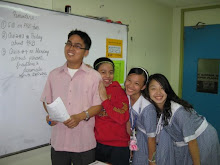
Early life and career
Joseph Marcelo Ejercito, popularly known as Erap, was born on April 19, 1937 in Tondo, the poorest district of Manila. He belonged to an upper middle class family, and was the eighth of ten children of Emilio Ejercito, a government engineer, and his wife Maria Marcelo. He finished his primary studies at the Ateneo de Manila University, but was expelled in his sophomore year of high school for unruly behavior.[3] He went to Mapúa Institute of Technology to continue schooling with an engineering course, but dropped out from studies altogether two years later.
In his twenties, he began a career as a film actor. He adopted the screen name "Joseph Estrada", as his father objected to his chosen career and his decision to quit schooling. He also acquired the nickname "Erap" (a play on the Tagalog word "pare", meaning buddy) from his good friend Fernando Poe, J
Vice-Presidency
See Also: Presidency of Fidel V. Ramos
In 1992, Joseph Estrada ran for vice-president as the running mate of Eduardo Cojuangco, Jr. under the Nationalist People's Coalition party. Though the latter lost to former National Defense Secretary Fidel Ramos, Estrada won the vice-presidency garnering more votes than his closest opponent, Ramon Mitra, Jr.'s running mate, Marcelo Fernan.
As Vice-President, he as the chairman of President Ramos' Presidential Anti-Crime Commission (PACC). Estrada arrested criminal warlords and kidnapping syndicates. He resigned as chairman of the PACC on 1997. In 1997 Vice-President Estrada, together with former President Corazon Aquino, Jaime Cardinal Sin, Senator Gloria Macapagal Arroyo and other political leaders, led an anti-charter change rally brought in an estimated half a million people to Rizal Park against the charter change moves by supporters of President Fidel Ramos.
1998 Presidential Elections
Estrada’s political strategists and financial backers were aware that a large share of the Philippine electorate, the "masa" (the poor and undereducated masses), were looking for a leadership they could relate to. Estrada’s financial backers designed a campaign strategy that reflected Estrada’s pro-poor image that he had built up throughout his movie career. Central in the campaign was Estrada’s campaign slogan "Erap para sa Mahirap" (Erap for the poor) that succeeded in inspiring the masses with the hope that Estrada would be the president of and for the masses. Estrada's running mate, Edgardo Angara, was defeated by Gloria Macapagal-Arroyo. During the campaign, Estrada's political rivals tried but failed to discredit him while publicizing his womanizing, drinking and gambling.
Presidency
Estrada was inaugurated on June 30, 1998 in the historical town of Malolos in Bulacan province in paying tribute to the cradle of the First Philippine Republic. That afternoon the new president delivered his inaugural address at the Quirino Grandstand in Luneta. He assumed office amid the Asian Financial Crisis and with agricultural problems due to poor weather conditions, thereby slowing the economic growth to -0.6% in 1998 from a 5.2% in 1997. The economy recovered by 3.4% in 1999 and 4% in 2000. In 2000 he declared an "all-out-war" against the Moro Islamic Liberation Front and captured it's headquarters and other camps. However, allegations of corruption spawned an impeachment trial in the Senate, and in 2001 Estrada was ousted from power after the trial was aborted.
In his Inaugural Address, Estrada said:


No comments:
Post a Comment